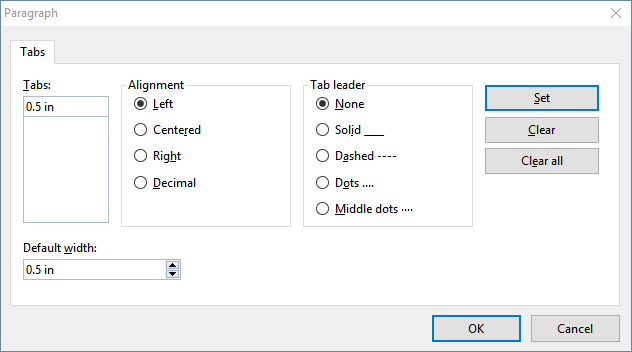By default, tab stops are preset at 0.5 inch intervals. However, these preset tab stops are merely relics from the era of the typewriter, and you should take the opportunity to set your own tab stops.
Since tabs count as part of paragraph formatting, you can define different tab stops for each paragraph of the document.
To set tab stops, proceed as follows:
| 1. | Place the text cursor in the desired paragraph (or select several paragraphs). |
| 2. | On the ribbon tab Layout | group Paragraph, click on the Tabs icon |
 |
| 3. | Enter the desired position relative to the left margin under Tabs – the left margin corresponds to "0". |
| 4. | If desired, select another Alignment and another Tab leader for the tab (see below). |
| 5. | Don't forget: Click on the Set button. |
| 6. | If necessary, set up additional tab stops in the same way before you exit the dialog box with OK. |
Once tab stops have been set, you can use the Tab key to insert tabs in the text to move from one tab stop to the next.
Note: You can also use this dialog box to enter the Default width for the predefined tab stops mentioned earlier (0.5 inch by default). If you define your own tabs in a paragraph, however, the predefined tabs are overridden.
Tab alignment
You use the option Alignment in the above dialog box to specify the alignment of a tab stop.
Available options:
Alignment |
Explanation |
Left |
This is a normal "left-aligned" tab stop. This tab stop determines where the following text begins. |
Centered |
The text after the tab is centered on the tab position. This tab stop determines where the middle of the text falls. |
Right |
Here, the text after the tab is right-aligned. This tab stop determines where the text ends. |
Decimal |
This option is used for formatting columns of numbers. The numbers are positioned in such a way that their decimal points are vertically aligned. |
Tip: To change the alignment of existing tab stops, click on the Tabs icon ![]() on the ribbon tab Layout | group Paragraph. Then select one of the set tab stops in the dialog box, change its alignment in the dropdown list Alignment and confirm with Set.
on the ribbon tab Layout | group Paragraph. Then select one of the set tab stops in the dialog box, change its alignment in the dropdown list Alignment and confirm with Set.
Tab leader
You can also use the option Tab leader to specify a tab leader for a tab stop. This is then used to fill the space that the tab skips.
Available options:
None |
A tab without a leader |
Solid |
A tab with underscores as leaders |
Dashed |
A tab with dashes as leaders |
Dots |
A tab with dots as leaders (used frequently in tables of contents and indexes) |
Middle dots |
A tab with middle dots as leaders |
Tip: To add leaders to existing tab stops, click on the Tabs icon ![]() on the ribbon tab Layout | group Paragraph. In the dialog box, select one of the set tab stops, choose the required character from the list Tab leader, and confirm your selection with Set.
on the ribbon tab Layout | group Paragraph. In the dialog box, select one of the set tab stops, choose the required character from the list Tab leader, and confirm your selection with Set.